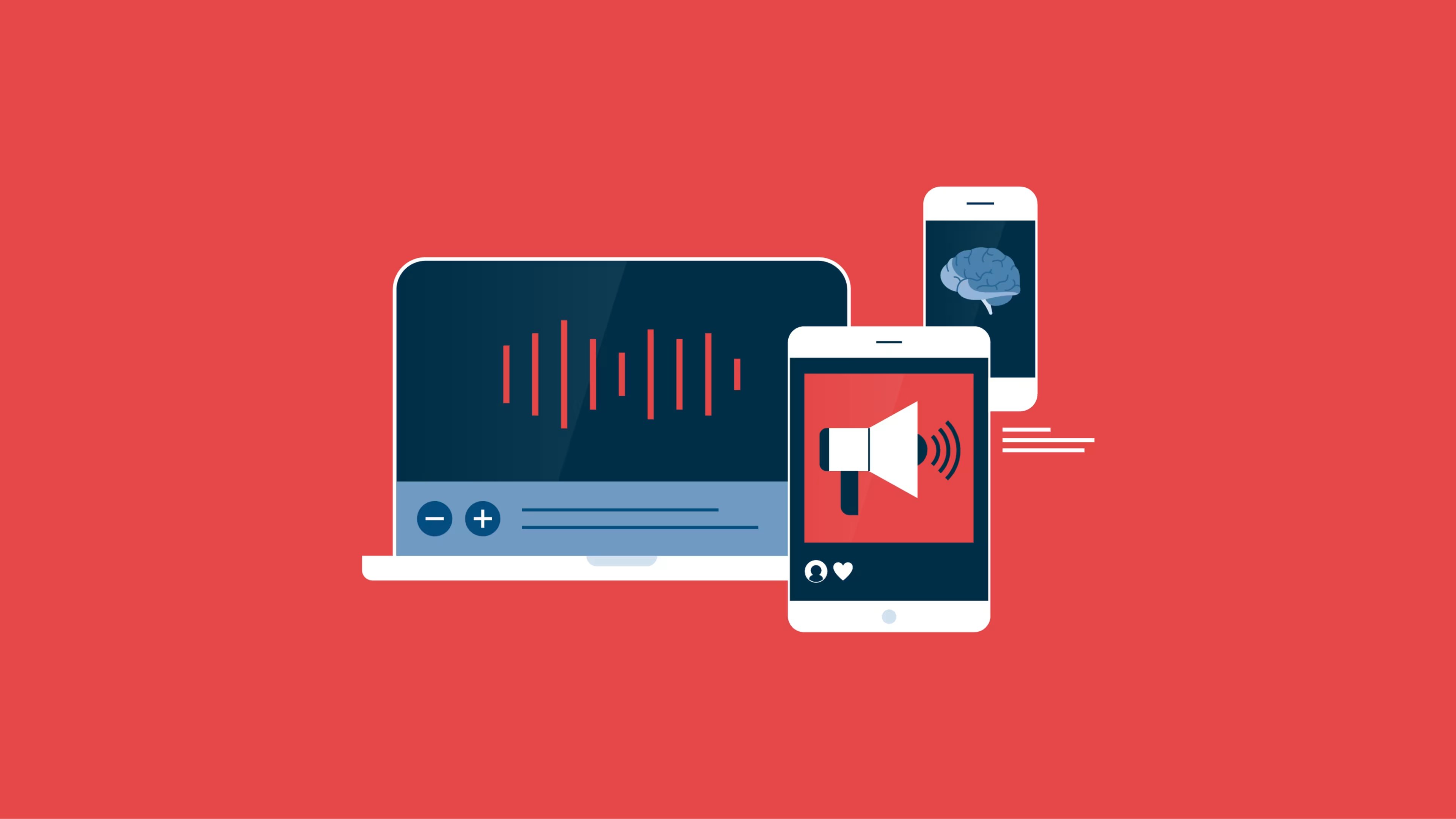New survey research from Capterra finds that companies are doing more to provide accessible digital marketing in 2022. Here’s how you can too.
One in four U.S. adults live with some type of physical or mental disability[1]. Yet they are often excluded from receiving digital marketing messages due to accessibility barriers. If your marketing content isn’t accessible to all people, you could be alienating entire swathes of potential customers, limiting the reach of your company, and even damaging your brand.
Capterra’s 2022 Accessible Marketing Survey gathered insights from over 400 U.S. marketers to reveal which accessibility features and functionality marketers are currently offering their customers and what barriers still exist in this space[*]. We’ll also provide specific recommendations to help your company improve marketing accessibility.
Key findings
Marketers are moving toward accessibility but are still not prioritizing it: A whopping 83% of marketers say their company is doing more to provide accessibility in digital marketing than it did in the past. Yet, the majority say they account for common demographics in their marketing (e.g., age, gender, race, etc.) before factors like physical ability.
Marketers aren’t focused on compliance: Many marketers aren’t familiar with specific disability compliance laws. For example, half of all marketers (50%) surveyed believe that there is no U.S. law requiring federal government websites to be safe and accessible for people with disabilities when in fact, there is—this is commonly known as Section 508.
Cognitive disabilities should receive more attention from marketers: Marketers report that their company is more likely to provide visual (66%) and hearing (56%) accessibility features than cognitive features. They also wrongly believe that visual and hearing disabilities are the most prevalent when in fact cognitive disabilities are more common.
Accessibility is most challenging on social media: Nearly half (49%) of marketers say social media is the most difficult platform or channel to provide accessibility features for.
Marketers need accessibility support: 45% of marketers say that education or accessibility training would motivate their company to be more proactive in improving the accessibility of their digital marketing. Additionally, more than one in four marketers cite the lack of technology or staff to implement features as a top barrier to creating accessible digital marketing.
What is accessible marketing?
Accessible marketing is when products, services, media, and marketing are specifically designed so that everyone (including people with disabilities or impairments) can fully experience them.
It’s about making it easier for all consumers to receive and understand your marketing messages. This could mean providing the content in alternate formats (e.g., captions, color adjustments, high contrast, etc.), or by enabling content to be consumed via assistive technologies (e.g., screen reading software, text-to-speech systems, etc.).
Marketers are making strides on accessibility, but there's room to grow
Our survey found that 69% of marketers believe that providing accessibility features is important to executing successful marketing campaigns. In fact, the majority of marketers are more proactive about accessibility right now, with 83% indicating that their company is doing more to provide accessibility in digital marketing than it did in the past.
Accessibility is an important aspect of marketing that is getting more attention than it used to. However, there’s room for improvement as accommodating individuals with disabilities isn’t typically at the top of a marketer’s priority list.
When we asked marketers about the attributes their company takes into account when marketing to consumers, ability was not a top consideration. Only 35% of marketers say that their company accounts for physical ability when marketing to consumers. Common demographics such as age and gender take the top consideration.
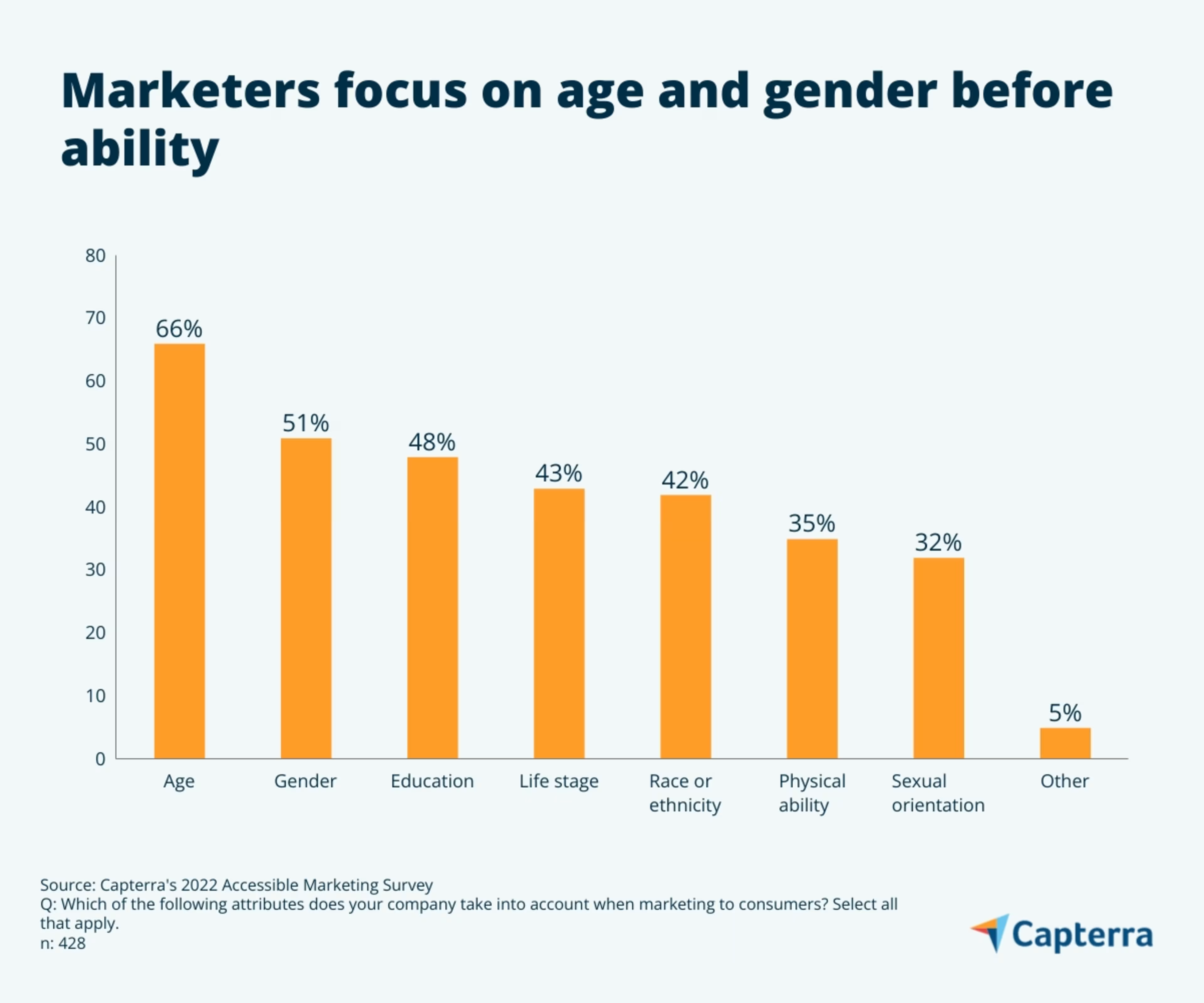
Let’s take a look at where companies are when it comes to providing specific accessible marketing features.
Digital marketers hone in on visual accessibility features
Our data shows that the majority of companies are providing visual, auditory, and speech features for their digital marketing content. Visual accessibility features are the most common with 66% of all marketers indicating that their digital marketing content accounts for visual impairments.
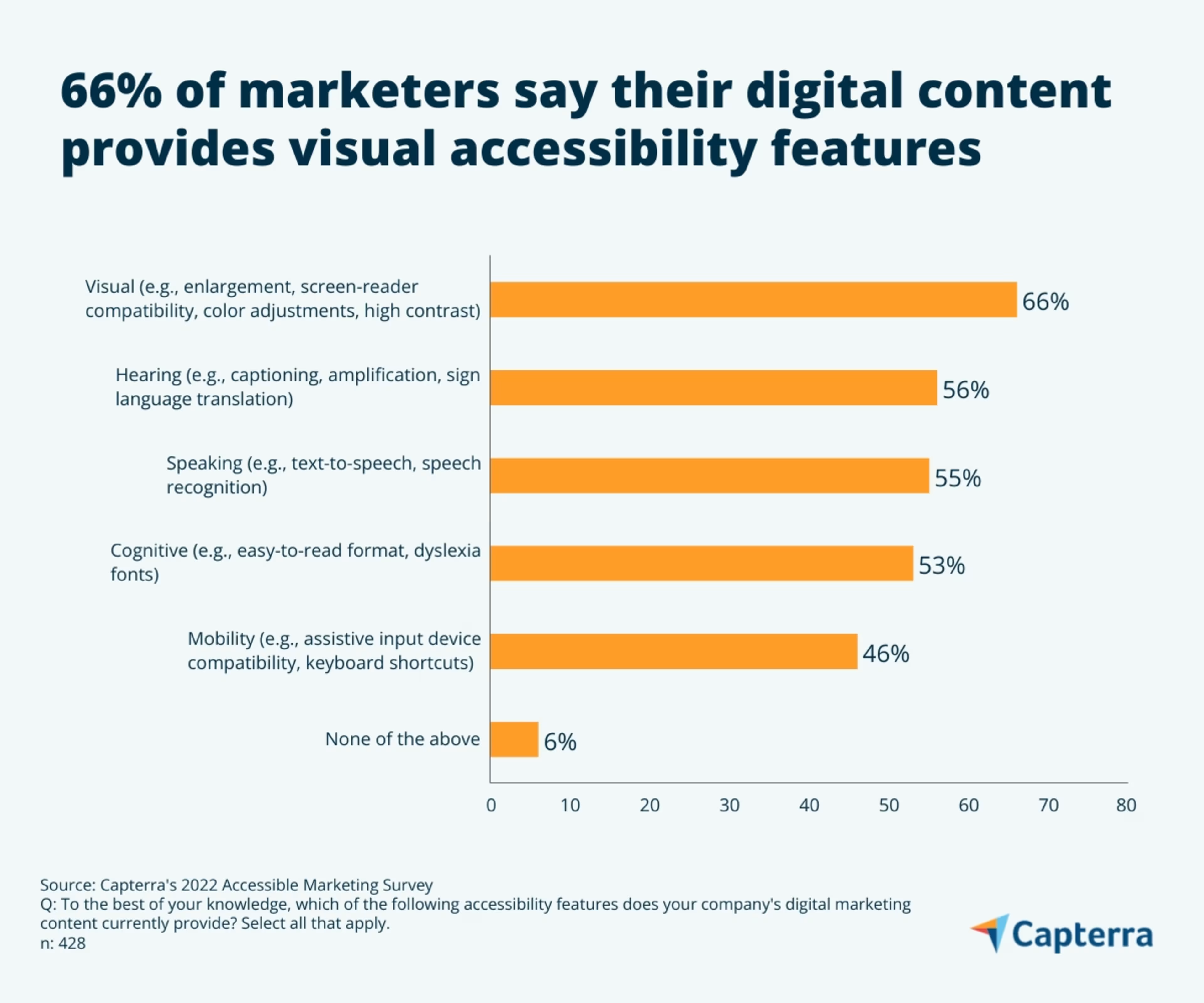
Visual features are also the digital marketing accessibility feature that marketers would most like their company to offer—the majority suggested options such as bigger and bolder fonts, larger buttons, or link or image descriptions.
Overall, marketers that currently provide accessibility features in their digital marketing content rate them as fairly effective when it comes to achieving accessibility. They rate all feature types as very or somewhat effective, with speaking features performing slightly poorer compared to all other types measured.
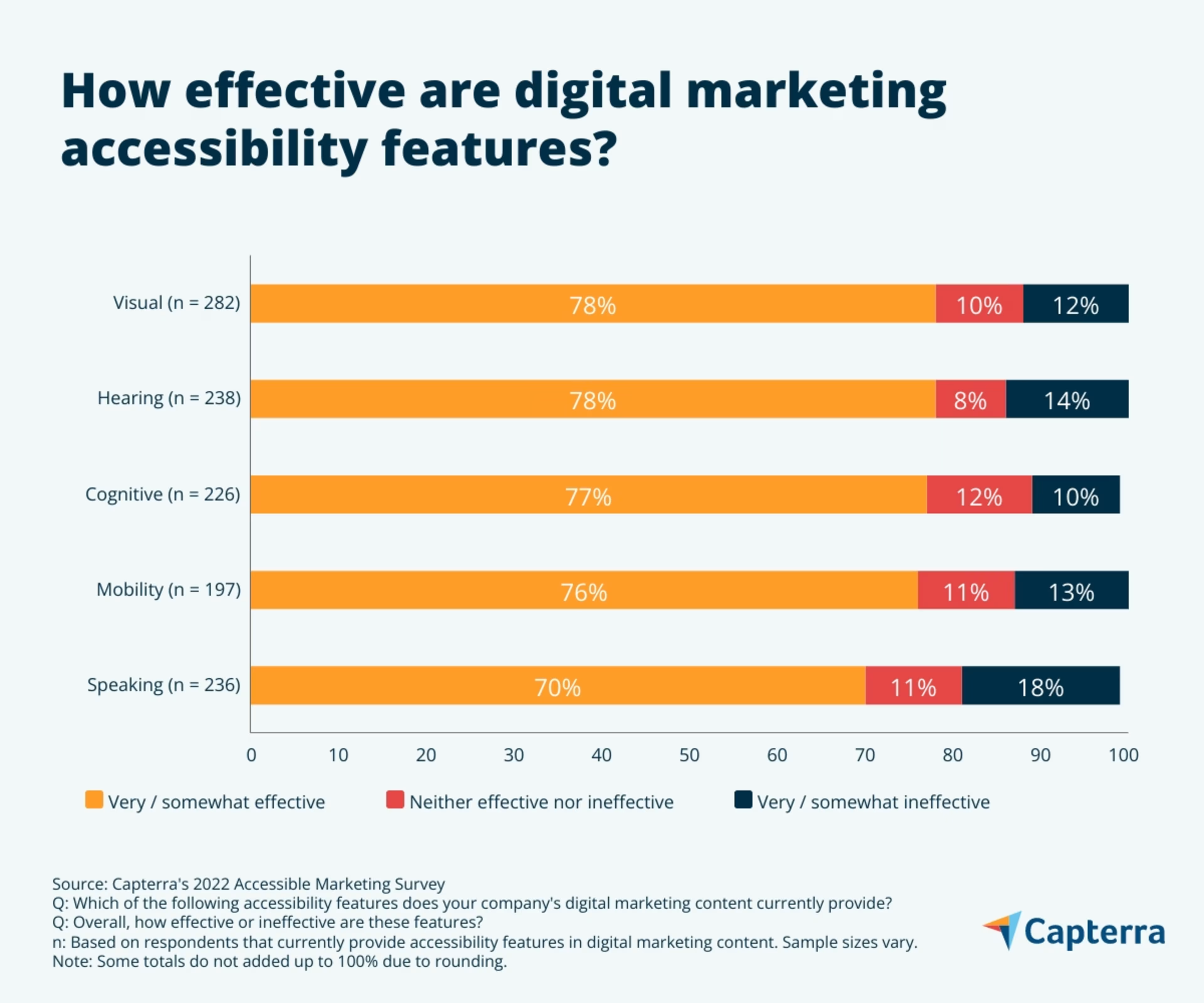
Among marketers, speaking and voice assistive technology leaves something to be desired. Our marketers say they’d like “more intelligent” or “more agile” voice access to digital marketing content.
Having accessibility features in place is just one aspect of successful marketing. Let’s explore the roles involved with accessibility initiatives at companies.
D&I teams drive accessibility programs
Having support from various roles or departments and the right information can help guide accessibility initiatives at your company.
Diversity and inclusion (D&I) teams and human resource (HR) professionals play an important role in the accessibility space. According to our data, these professionals are more influential than even company executives. Diversity and inclusion refers to programs, policies, processes, or staff that support diverse groups of people working in an organization.
This could be attributed to the general growth of D&I efforts within companies. Gartner reports that nearly one-third of employees say DEI (diversity, equity, and inclusion) has been receiving more attention within their organizations in the last two years[2].
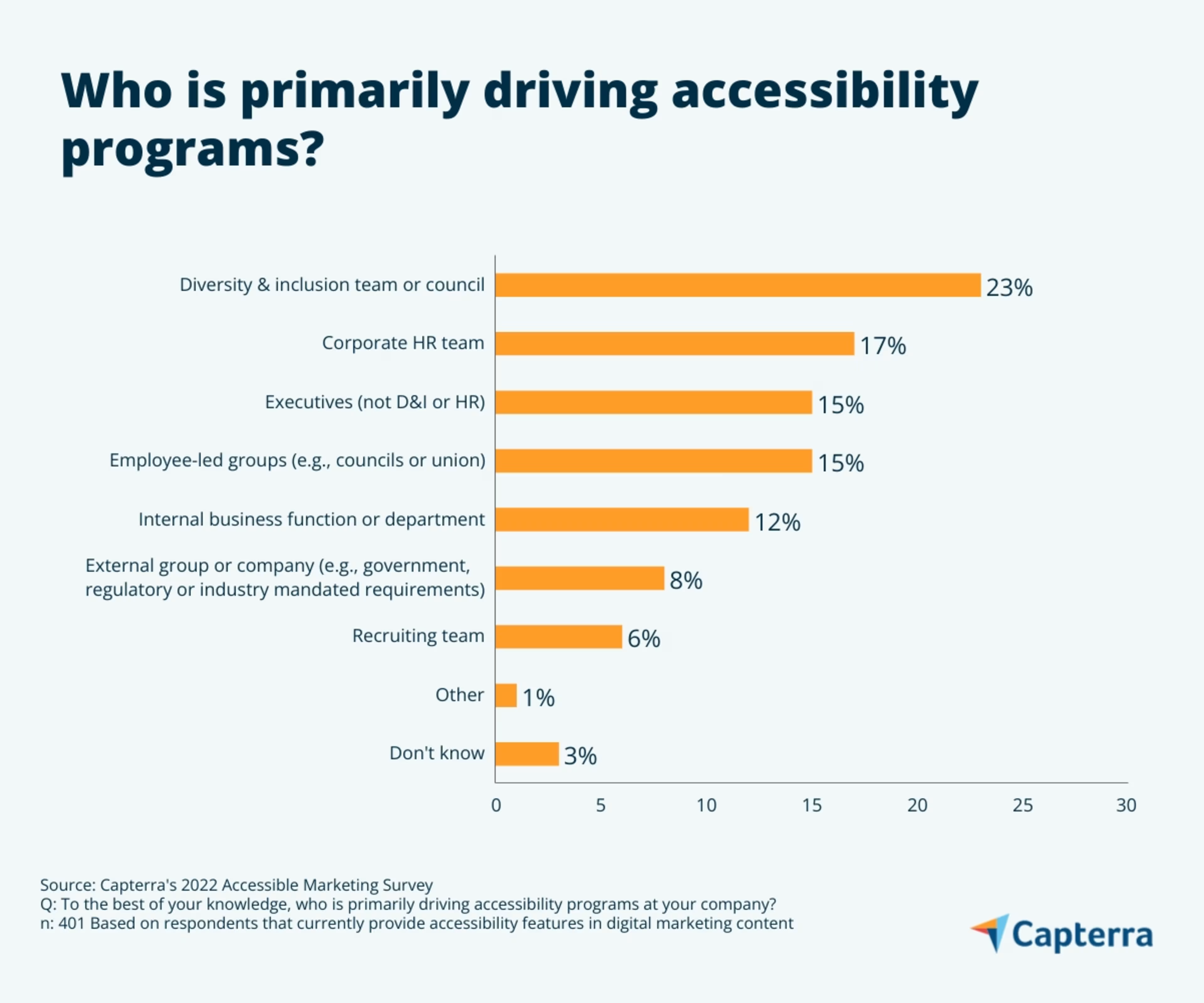
Next, our research explores what marketers know about accessibility laws and disability prevalence. Are they aware of the laws and regulations their content has to be compliant with? Do they know which types of disabilities are most prevalent in the U.S.?
There’s a lack of clarity surrounding accessibility laws and disability prevalence
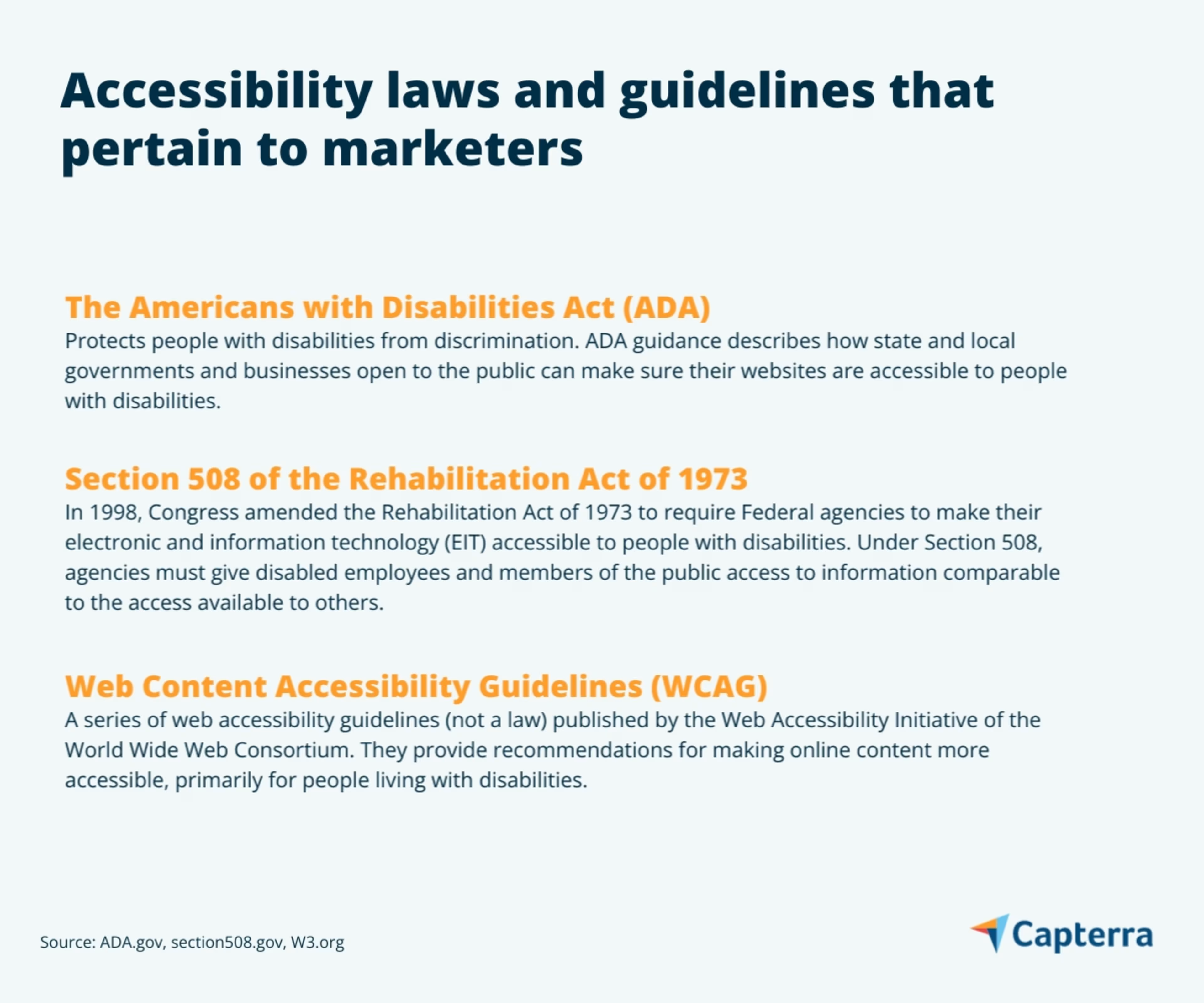
We found that many marketers aren’t very familiar with specific disability compliance laws. Below are a few examples from our survey:
Half of all marketers surveyed believe that there is no U.S. law requiring federal government websites to be safe and accessible for people with disabilities when in fact, there is (Section 508). Of those that are familiar with the law, only 7% can recall its name unaided.
42% of marketers believe that there is no U.S. law prohibiting discrimination based on disability when in fact, there is (The Americans with Disabilities Act). Of those that are familiar with the law, only a third of marketers (33%) can recall its name unaided.
83% of marketers believe that businesses that do not adhere to WCAG guidelines can be fined when in fact there is no fine.
Furthermore, our survey found that marketers believe visual and hearing disabilities are more prevalent than cognitive disabilities, when in fact cognitive disabilities are more prevalent comparatively[1].
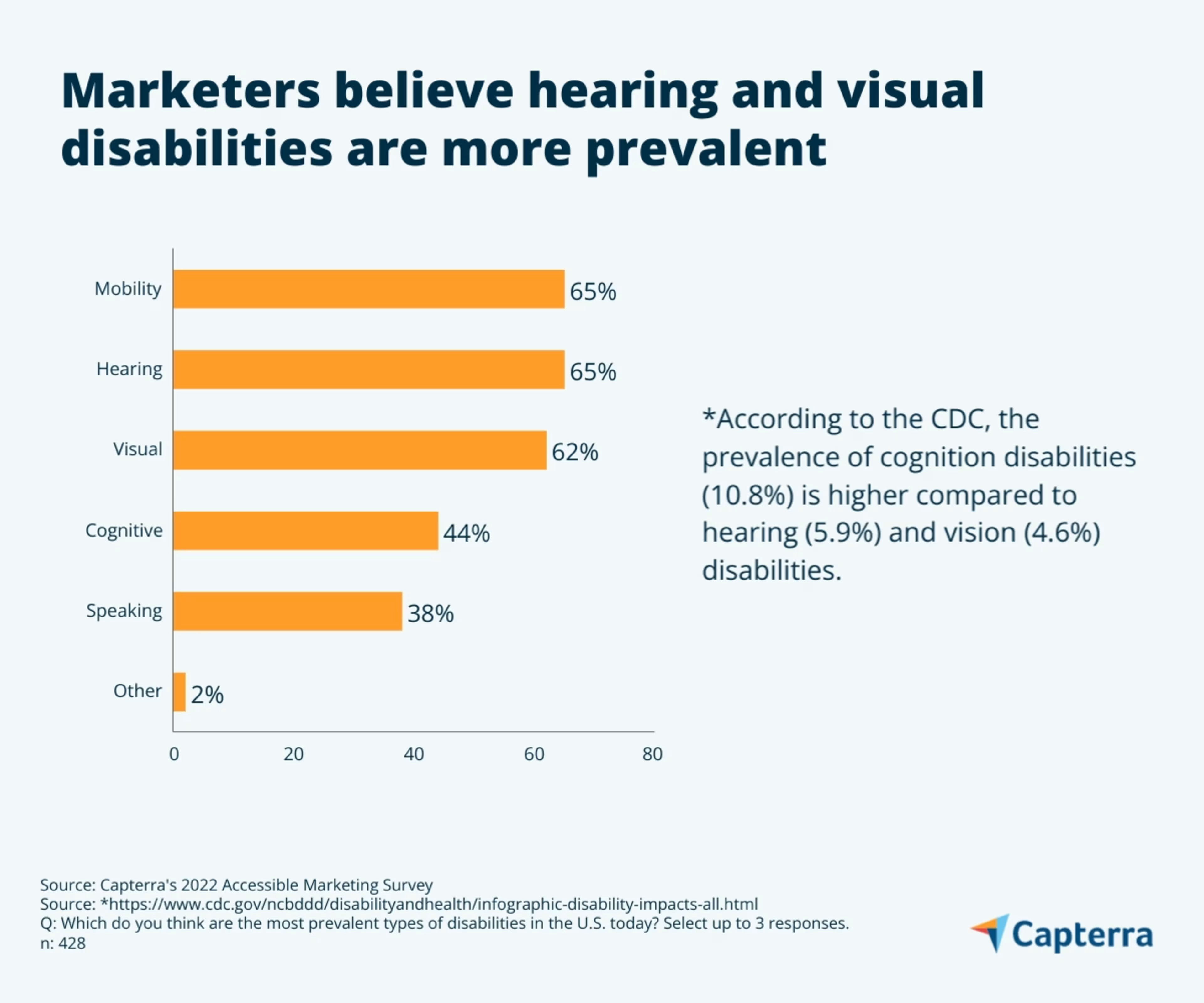
Evidence suggests that marketers looking to improve accessibility should consider bolstering features for individuals living with cognitive disabilities (e.g., difficulty concentrating, remembering, or making decisions, etc.)—possibly an overlooked audience. In practice, this could entail altering the appearance of content so it’s easy to comprehend, well organized, clean, or simplified. Also, designing easy-to-navigate content with clearly identifiable links or buttons.
The top benefits of accessible digital marketing are customer-centric
Accessible marketing can lead to better outcomes for customers, and in turn, lead to increased revenue for your company.
Our data shows that incorporating accessibility features in digital marketing does move the needle —especially by improving customer outcomes. Among marketers that use accessibility features in their digital content, the top benefits are improved customer service, loyalty, retention, and better usability of digital content.
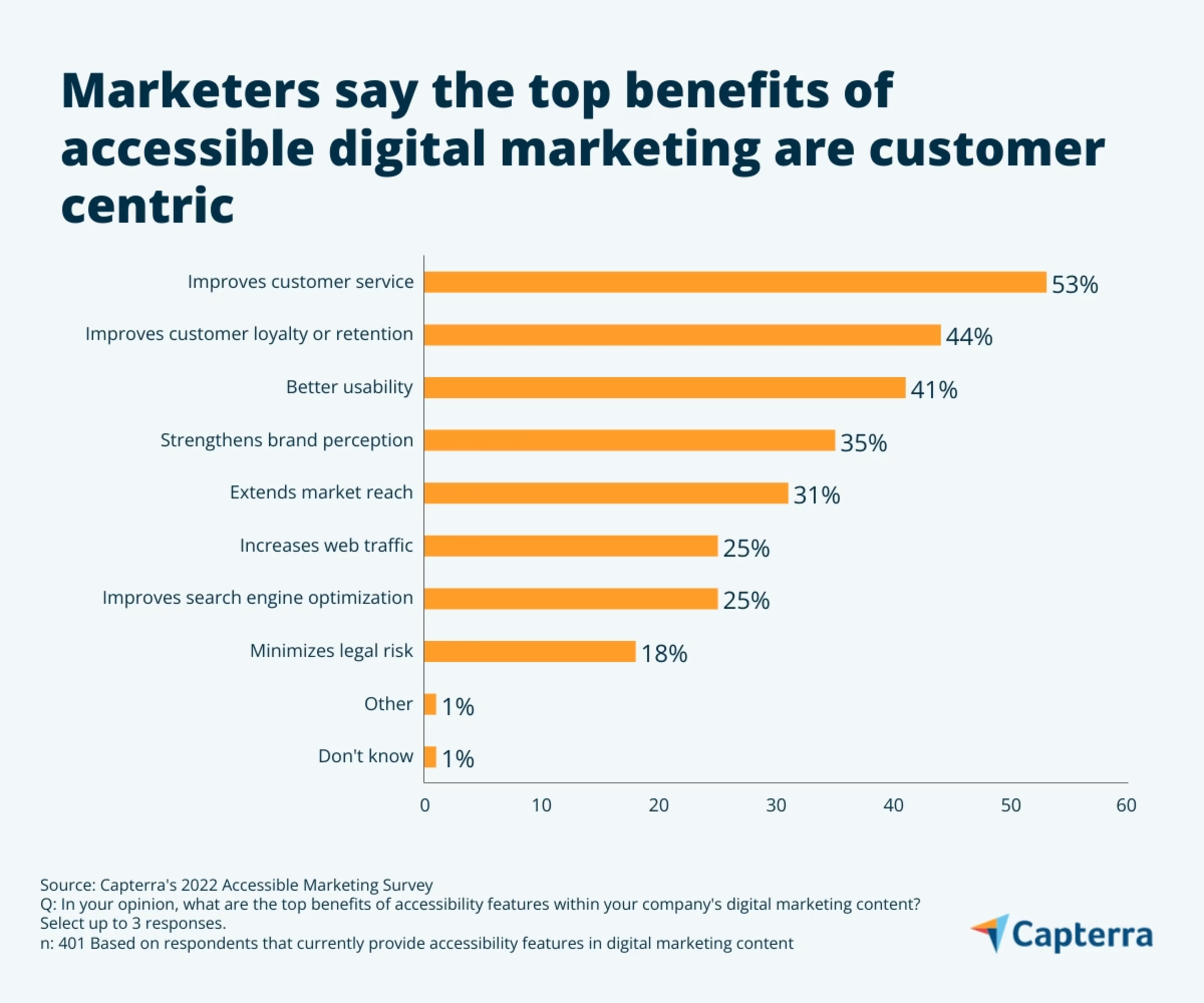
It’s important to note that minimizing legal risk is at the bottom of the list, suggesting that compliance is not the main focus among marketers. Companies appear to be driven ultimately by the need to better serve customers.
Another key benefit of making your digital marketing content accessible is that it helps build your brand perception. When your company ensures content is fully accessible to all people, its communicating qualities such as inclusivity, transparency, responsiveness, openness, and more.
Delivering accessible marketing is indeed beneficial, yet it’s an ongoing process in an evolving online environment. Below are some considerations when implementing accessibility features.
Cost is the top barrier to accessible digital marketing
Despite good intentions, it can be difficult for some companies to make accessibility features readily available. According to our survey, accessibility initiatives are hindered mainly due to cost, technology, and staffing challenges.
The harsh reality is that getting the staffing and technology to support accessibility initiatives might only be available to companies that have the budget. For example, nearly two in five marketers say that the cost of implementing accessibility features in their digital marketing content is a top challenge. Additionally, 69% of marketers strongly or somewhat agree that it is expensive to create accessible digital marketing these days.
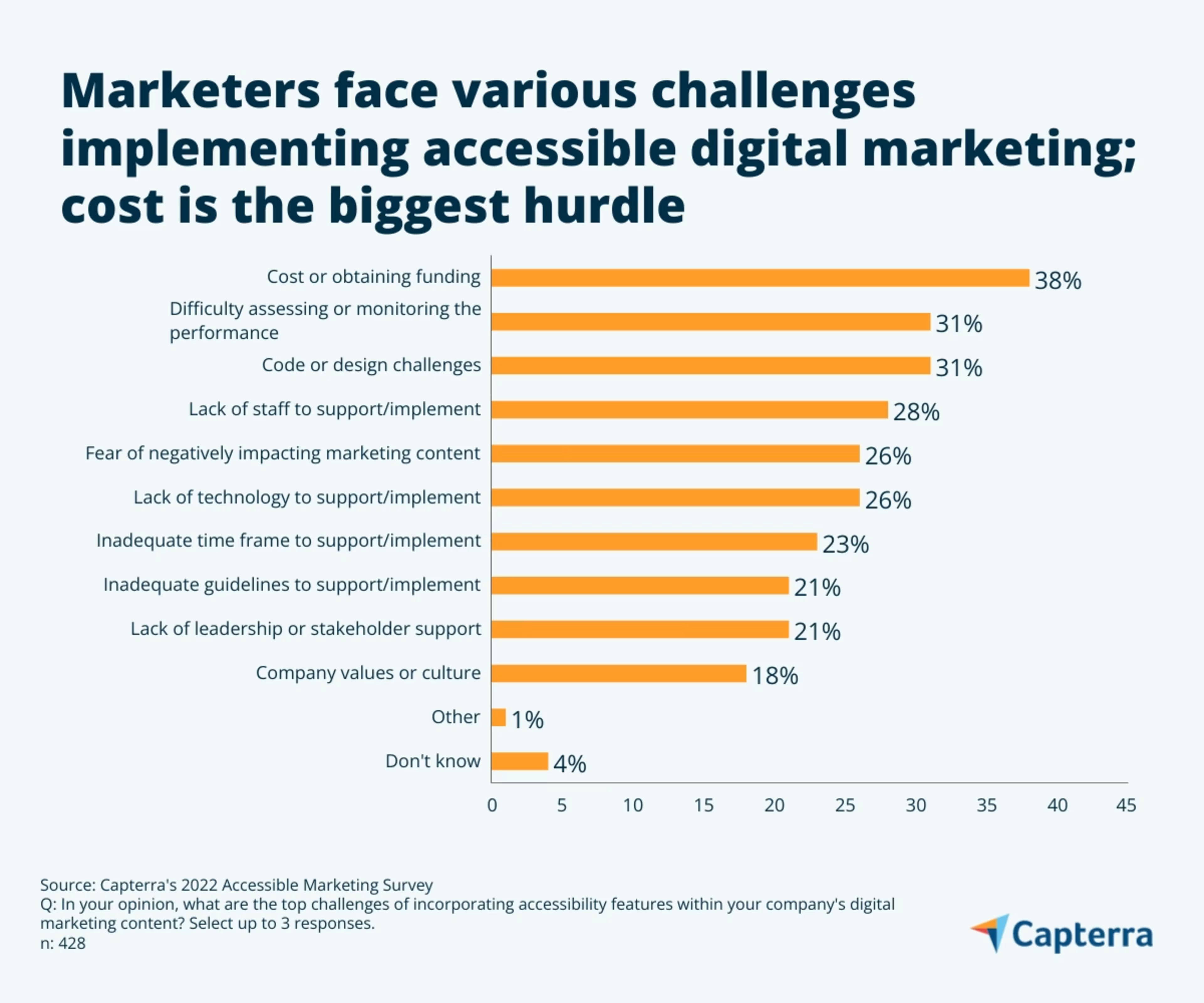
Almost half (49%) of marketers say that social media is the most difficult platform or channel to provide accessibility features for. This might be due to the nature of social media’s constantly changing features and multiple formats for posting content. That’s a lot to keep up with for busy marketers.
Surprisingly, email and website accessibility are still a challenge with about two in five marketers citing these platforms as the most difficult to add accessibility features to. Marketers all-in on accessibility shouldn’t overlook the most basic forms of digital communication with customers like email and websites (often the first impression of a company).
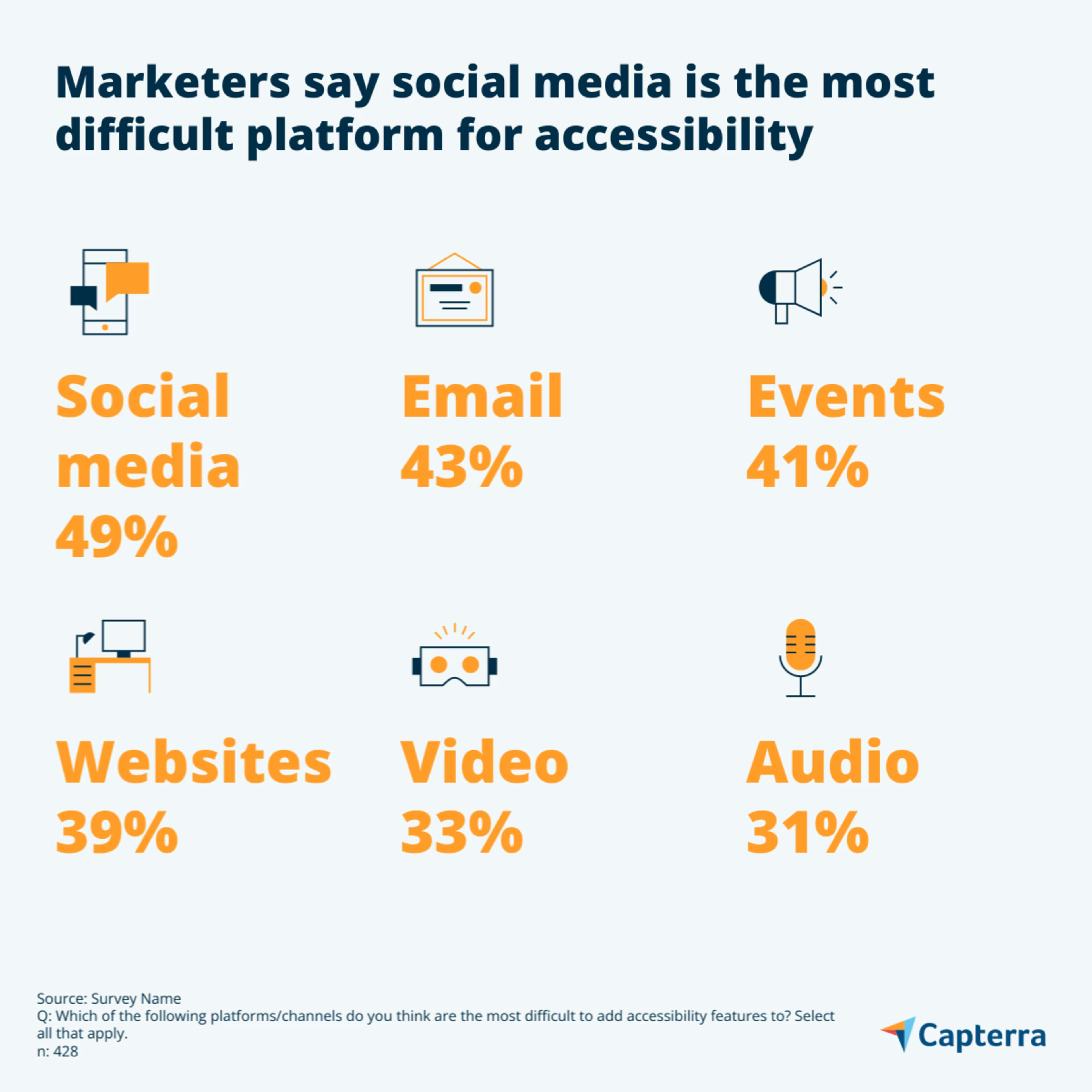
What companies can do right now to improve accessibility in their marketing
Rest assured, there are many avenues to move your company towards accessible marketing, despite the challenges.
Education and training is a must-have
If education or training materials were readily available, our data indicates that there is interest among marketers. For example, 45% of marketers say that education or accessibility training would motivate their company to be more proactive in improving the accessibility of their digital marketing.
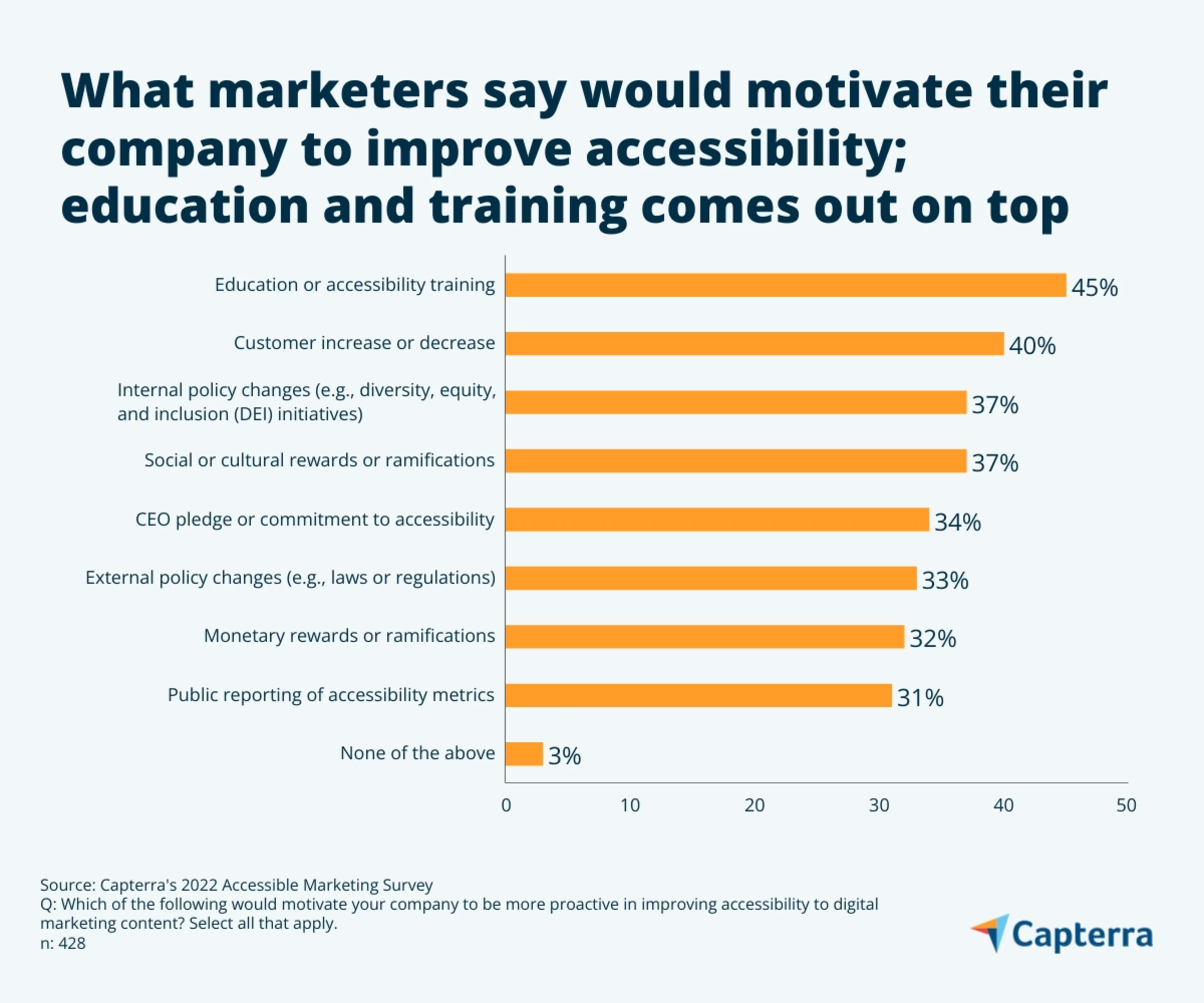
Earlier in this report, we identified a few areas where additional information could be needed—specifically stats on disability prevalence and explanation of accessibility law. These are good areas to start providing education or training materials.
Seek varied perspectives
It’s important for marketers to consider the level of diversity across their company’s workforce. Our survey found that nearly a third of marketers (32%) disagree that their company has a representative number of individuals with disabilities on staff.
Companies must strive to hire and retain diverse talent —meaning people from all backgrounds with a variety of abilities. Why does this matter? Because like any other marketing initiative, accessibility efforts require strong feedback. Marketers should start by soliciting feedback from or working directly with individuals living with disabilities. Their first-hand knowledge and feedback is a valuable resource to guide accessibility improvements that can be shared across the marketing team.
Lean on technology
One in four marketers say that the lack of technology to implement features is a top barrier to creating accessible digital marketing. The right accessibility software can help your company ensure that online content is accessible for individuals with disabilities and in compliance with accessibility laws. These tools can provide a multitude of functions like automated compliance checking, testing or performance evaluation, and more.
Taking on accessible marketing is a more complex undertaking than one might imagine but it’s certainly worth the effort.
There are free online resources that can help you learn more about accessibility issues. For example, WAI, the W3C Web Accessibility Initiative, has web content accessible guidelines that can help you as you implement accessibility features[3].
You should make accessible marketing imperative, if you aren’t already. It’s a powerful way not only to reach more customers, but to generate a positive brand perception. Ultimately, you’ll be serving the needs of your customers, establishing better connections and doing the right thing.
If you enjoyed this report, check out these additional resources:
Is Your Marketing Strategy Accessible? Tips from a Business Owner
How You Can Boost Your Martech Effectiveness with a Marketing Operations Manager

